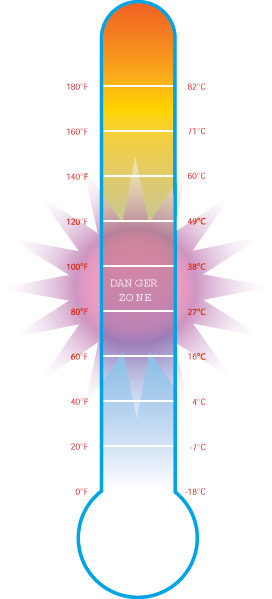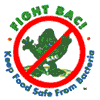FOOD SERVICE SAFETY FACTS
April 2002 | 
|
|
(also available in PDF)

Fresh eggs may contain bacteria called Salmonella Enteritidis (SE) that can cause intestinal infections. Most healthy people recover from these infections within 4-7 days, but they can lead to severe and even fatal illness, especially for those most vulnerable to foodborne disease -- young children, the elderly, and persons with immune systems weakened by health problems. Illness from eggs -- or foods that contain them -- can be prevented by proper preparation procedures and cooking to safe temperatures.
![]() Raw shell eggs that have not been treated to destroy Salmonella must be refrigerated at 7°C (45°F) or below while stored or displayed.
Raw shell eggs that have not been treated to destroy Salmonella must be refrigerated at 7°C (45°F) or below while stored or displayed.
![]() All packages of raw shell eggs not treated to destroy Salmonella must carry this safe handling statement--
All packages of raw shell eggs not treated to destroy Salmonella must carry this safe handling statement--
SAFE HANDLING INSTRUCTIONS: TO PREVENT ILLNESS FROM BACTERIA: KEEP EGGS REFRIGERATED, COOK EGGS UNTIL YOLKS ARE FIRM, AND COOK FOODS CONTAINING EGGS THOROUGHLY.
![]() Accept liquid, frozen and dried eggs and egg products only if pasteurized.
Accept liquid, frozen and dried eggs and egg products only if pasteurized.
![]() Wash, rinse and sanitize utensils, equipment and work surfaces after preparing eggs or egg-containing foods.
Wash, rinse and sanitize utensils, equipment and work surfaces after preparing eggs or egg-containing foods.
![]() Keep cooked ready-to-eat eggs and egg-containing foods separate from raw animal-derived foods during storage, preparation, holding or display.
Keep cooked ready-to-eat eggs and egg-containing foods separate from raw animal-derived foods during storage, preparation, holding or display.
![]() Substitute treated eggs or pasteurized egg products for raw shell eggs in preparing such foods as Caesar salad, hollandaise or béarnaise sauce, mayonnaise, eggnog, ice cream, and eggfortified beverages that are not thoroughly cooked. (See minimum cooking times and temperatures opposite.)
Substitute treated eggs or pasteurized egg products for raw shell eggs in preparing such foods as Caesar salad, hollandaise or béarnaise sauce, mayonnaise, eggnog, ice cream, and eggfortified beverages that are not thoroughly cooked. (See minimum cooking times and temperatures opposite.)

![]() Cook foods prepared with raw shell eggs that are not broken for immediate preparation and service to heat all parts of the food to a temperature of 68°C (155°F) for 15 seconds.
Cook foods prepared with raw shell eggs that are not broken for immediate preparation and service to heat all parts of the food to a temperature of 68°C (155°F) for 15 seconds.
![]() Eggs and egg-containing foods cooked in a microwave oven should be: covered to retain surface moisture; rotated or stirred throughout or midway through cooking to promote even heat distribution; heated to a temperature of at least 74°C (165°F), and allowed to stand covered for 2 minutes before service.
Eggs and egg-containing foods cooked in a microwave oven should be: covered to retain surface moisture; rotated or stirred throughout or midway through cooking to promote even heat distribution; heated to a temperature of at least 74°C (165°F), and allowed to stand covered for 2 minutes before service.
![]() For cold holding, maintain cooked eggs and egg containing foods at 5°C (41°F) or below.
For cold holding, maintain cooked eggs and egg containing foods at 5°C (41°F) or below.
![]() In NO case should soft-cooked eggs, soufflés or meringues or other foods that contain raw or undercooked eggs be served in these facilities.
In NO case should soft-cooked eggs, soufflés or meringues or other foods that contain raw or undercooked eggs be served in these facilities.
![]() As a general rule, treated eggs or pasteurized egg products should be used in any recipe that calls for combining more than one egg ("pooling") and for any recipe, preparation or serving procedure that involves holding eggs or egg-containing foods before or after cooking.
As a general rule, treated eggs or pasteurized egg products should be used in any recipe that calls for combining more than one egg ("pooling") and for any recipe, preparation or serving procedure that involves holding eggs or egg-containing foods before or after cooking.
![]() To add an extra margin of safety, in addition to all of the above precautions, buyers can specify that suppliers provide eggs produced only from flocks managed under an SE control program that is recognized by a state regulatory agency or a state poultry association.
To add an extra margin of safety, in addition to all of the above precautions, buyers can specify that suppliers provide eggs produced only from flocks managed under an SE control program that is recognized by a state regulatory agency or a state poultry association.
Consumers should be informed of the significantly increased health risk -- especially to young children, elderly persons and individuals with weakened immune systems -- when eggs are eaten in a raw or undercooked form. Foods such as scrambled or fried eggs, French toast and omelets are frequently undercooked, while other foods, such as hollandaise or béarnaise sauce, mayonnaise, and chocolate mousse, may contain raw or undercooked eggs. Consumers can be so informed by brochures, advisories on signs or menus, table tents, labeling or other effective written means.

|
To access the U.S. Food and Drug Administration's Food |
Hypertext updated by cjm 2002-MAY-01